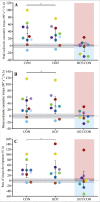No clear benefit of muscle heating on hypertrophy and strength with resistance training
- PMID: 30393753
- PMCID: PMC6209423
- DOI: 10.1080/23328940.2017.1391366
No clear benefit of muscle heating on hypertrophy and strength with resistance training
Abstract
Heat is a major stressor during exercise, though its value in driving adaptation is not well understood. Muscle heating can upregulate pathways facilitating protein synthesis and could thereby enhance effects of exercise training, however, few studies have investigated this possibility. We examined whether heating active muscle during resistance training differentially affected physical and functional adaptations. Within a randomised contralateral-limb control study, ten healthy, resistance-untrained individuals (21 ± 3 y; 5 female) completed 30 sessions of progressive resistance training (12 weeks), performing 4 × 8 unilateral knee extensions at 70% of 1RM. One randomly-allocated thigh was heated during, and for 20 min after, each session using an electric pad eliciting muscle temperatures of >38 °C (HOT); the contralateral limb remained unheated (CON). Training intensity was progressed using 4-weekly strength assessments. Quadricep lean mass (measured using DXA) increased by 15 ± 7% in HOT (p = 0.00) and 15 ± 6% in CON (p = 0.00); the difference being trivial (p = 0.94). Peak isokinetic torque at 90°.s-1 increased by 30 ± 25% (HOT; p = 0.00) and 34 ± 33% (CON; p = 0.01), with no difference (p = 0.84) between limbs. Rate of torque development increased ∼40%, with no difference between limbs (p = 0.73). The increase in 3-RM strength was also similar in HOT (75 ± 16%) and CON (71 ± 14%; p = 0.80 for difference). No differences in mass or strength changes were evident between sexes. In conclusion, supplemental heating of active muscle during and after each bout of resistance training showed no clear positive (or negative) effect on training-induced hypertrophy or function.
Keywords: DXA; females; force; isokinetic; quadriceps; torque.
Figures





Similar articles
-
Comparing the Effectiveness of Blood Flow Restriction and Traditional Heavy Load Resistance Training in the Post-Surgery Rehabilitation of Anterior Cruciate Ligament Reconstruction Patients: A UK National Health Service Randomised Controlled Trial.Sports Med. 2019 Nov;49(11):1787-1805. doi: 10.1007/s40279-019-01137-2. Sports Med. 2019. PMID: 31301034 Clinical Trial.
-
Strength training at high versus low external resistance in older adults: effects on muscle volume, muscle strength, and force-velocity characteristics.Exp Gerontol. 2013 Nov;48(11):1351-61. doi: 10.1016/j.exger.2013.08.010. Epub 2013 Aug 30. Exp Gerontol. 2013. PMID: 23999311 Clinical Trial.
-
Selective hypertrophy of the quadriceps musculature after 14 weeks of isokinetic and conventional resistance training.Clin Physiol Funct Imaging. 2017 Mar;37(2):137-142. doi: 10.1111/cpf.12277. Epub 2015 Jul 17. Clin Physiol Funct Imaging. 2017. PMID: 26184103 Clinical Trial.
-
Early phase adaptations in muscle strength and hypertrophy as a result of low-intensity blood flow restriction resistance training.Eur J Appl Physiol. 2018 Sep;118(9):1831-1843. doi: 10.1007/s00421-018-3918-8. Epub 2018 Jun 22. Eur J Appl Physiol. 2018. PMID: 29934764
-
American College of Sports Medicine position stand. Progression models in resistance training for healthy adults.Med Sci Sports Exerc. 2009 Mar;41(3):687-708. doi: 10.1249/MSS.0b013e3181915670. Med Sci Sports Exerc. 2009. PMID: 19204579 Review.
Cited by
-
Functional Impact of Post-exercise Cooling and Heating on Recovery and Training Adaptations: Application to Resistance, Endurance, and Sprint Exercise.Sports Med Open. 2022 Mar 7;8(1):37. doi: 10.1186/s40798-022-00428-9. Sports Med Open. 2022. PMID: 35254558 Free PMC article. Review.
-
The Effects of Combined Contrast Heat Cold Pressure Therapy on Post-Exercise Muscle Recovery in MMA Fighters: A Randomized Controlled Trial.J Hum Kinet. 2024 Sep 26;94:127-146. doi: 10.5114/jhk/190220. eCollection 2024 Oct. J Hum Kinet. 2024. PMID: 39563772 Free PMC article.
-
The combined influences of local heat application and resistance exercise on the acute mRNA response of skeletal muscle.Front Physiol. 2024 Oct 21;15:1473241. doi: 10.3389/fphys.2024.1473241. eCollection 2024. Front Physiol. 2024. PMID: 39497702 Free PMC article.
-
Skeletal muscle adaptations to heat therapy.J Appl Physiol (1985). 2020 Jun 1;128(6):1635-1642. doi: 10.1152/japplphysiol.00061.2020. Epub 2020 Apr 30. J Appl Physiol (1985). 2020. PMID: 32352340 Free PMC article.
-
The independent effects of local heat application on muscle growth program associated mRNA and protein phosphorylation.J Therm Biol. 2023 Jul;115:103602. doi: 10.1016/j.jtherbio.2023.103602. Epub 2023 Jun 10. J Therm Biol. 2023. PMID: 37331320 Free PMC article.
References
-
- Marini M, Veicsteinas A. The exercised skeletal muscle: a review. European J Transl Myol. 2010;20(3):105–120. 10.4081/bam;.2010.3.105 - DOI
-
- Wolfe RR. The underappreciated role of muscle in health and disease. Am J Clin Nutr. 2006;84(3):475–482. - PubMed
-
- Febbraio MA, Snow RJ, Stathis CG, Hargreaves M, Carey MF. Effect of heat stress on muscle energy metabolism during exercise. J Appl Physiol. 1994;77(6):2827–2831. - PubMed
LinkOut - more resources
Full Text Sources
